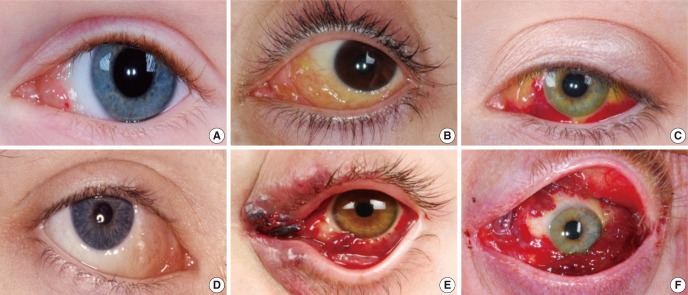Clin Exp Otorhinolaryngol.
2013 Mar;6(1):30-35.
Lymphatic Malformations of the Orbit
- Affiliations
-
- 1Department of Otolaryngology, Head and Neck Surgery, University Hospital Giessen & Marburg, Marburg, Germany. swiegand@med.uni-marburg.de
- 2Department of Ophthalmology, University Hospital Giessen & Marburg, Marburg, Germany.
Abstract
OBJECTIVES
Lymphatic malformations of the orbit are rare lesions that constitute approximately 1% to 8% of all orbital masses. They are difficult to treat since they do not remain within anatomic boundaries and tend to penetrate into normal orbital structures. The aim was to analyze clinical courses and therapy options in patients with lymphatic malformations of the orbit.
METHODS
Thirteen patients with orbital lymphatic malformations confirmed by magnetic resonance imaging between 1998 and 2009 were enrolled in this study. Patients' charts were retrospectively reviewed to analyze clinical courses and treatment options.
RESULTS
Four patients suffered from isolated intraorbital lymphatic malformations without conjunctival involvement, in three of them the masses were completely resected, in one patient close controls were performed. Three patients had isolated intraorbital lymphatic malformations with conjunctival involvement. Surgical volume reduction of the exterior parts of the lymphatic malformation were performed without any complications and satisfying outcome in these cases. Six patients suffered from intra- and periorbital lymphatic malformations. In 3 patients a watch-and-wait strategy was initiated. In the other 3 patients a surgical therapy was performed, one patient additionally received sclerotherapy with OK-432; however, these 3 patients suffered from residual lymphatic malformations.
CONCLUSION
The presented cases underline the inconsistencies in the malformations behavior and underscore the inability to make specific recommendations regarding treatment. The treatment decision should be based on the size and location of the lymphatic malformation. The untreated patient must be watched for signs of visual detoriation, which may signal the need for therapeutic intervention.
Keyword
MeSH Terms
Figure
Reference
-
1. Malhotra AD, Parikh M, Garibaldi DC, Merbs SL, Miller NR, Murphy K. Resection of an orbital lymphangioma with the aid of an intralesional liquid polymer. AJNR Am J Neuroradiol. 2005; Nov-Dec. 26(10):2630–2634. PMID: 16286413.2. Wiegand S, Eivazi B, Barth PJ, von Rautenfeld DB, Folz BJ, Mandic R, et al. Pathogenesis of lymphangiomas. Virchows Arch. 2008; 7. 453(1):1–8. PMID: 18500536.
Article3. Gürelik M, Ozum U, Erdoğan H, Aslan A. Orbital lymphangioma and its association with intracranial venous angioma. Br J Neurosurg. 2004; 4. 18(2):168–170. PMID: 15176559.
Article4. Graeb DA, Rootman J, Robertson WD, Lapointe JS, Nugent RA, Hay EJ. Orbital lymphangiomas: clinical, radiologic, and pathologic characteristics. Radiology. 1990; 5. 175(2):417–421. PMID: 2326469.
Article5. Eivazi B, Ardelean M, Bäumler W, Berlien HP, Cremer H, Elluru R, et al. Update on hemangiomas and vascular malformations of the head and neck. Eur Arch Otorhinolaryngol. 2009; 2. 266(2):187–197. PMID: 19052764.
Article6. Wiegand S, Eivazi B, Zimmermann AP, Sesterhenn AM, Werner JA. Sclerotherapy of lymphangiomas of the head and neck. Head Neck. 2011; 11. 33(11):1649–1655. PMID: 20737487.
Article7. Ogita S, Tsuto T, Tokiwa K, Takahashi T. Intracystic injection of OK-432: a new sclerosing therapy for cystic hygroma in children. Br J Surg. 1987; 8. 74(8):690–691. PMID: 3651773.
Article8. Saint-Louis LA, Haik BG, Amster JL. Magnetic resonance imaging of the orbit and optic pathways. Int Ophthalmol Clin. 1986; Fall. 26(3):169–185. PMID: 3781774.
Article9. Mortada A. Cystic lymphangioma of the orbit. Br J Ophthalmol. 1962; 1. 46(1):45–50. PMID: 18170753.
Article10. Iliff WJ, Green WR. Orbital lymphangiomas. Ophthalmology. 1979; 5. 86(5):914–929. PMID: 545219.
Article11. Zimmermann AP, Eivazi B, Wiegand S, Werner JA, Teymoortash A. Orbital lymphatic malformation showing the symptoms of orbital complications of acute rhinosinusitis in children: a report of 2 cases. Int J Pediatr Otorhinolaryngol. 2009; 10. 73(10):1480–1483. PMID: 19646769.
Article12. Hsuan J, Malhotra R, Davis G, Selva D. Orbital decompression for gross proptosis associated with orbital lymphangioma. Ophthal Plast Reconstr Surg. 2004; 11. 20(6):463–465.
Article13. Ogita S, Tsuto T, Nakamura K, Deguchi E, Tokiwa K, Iwai N. OK-432 therapy for lymphangioma in children: why and how does it work? J Pediatr Surg. 1996; 4. 31(4):477–480. PMID: 8801295.
Article14. Fujino A, Moriya Y, Morikawa Y, Hoshino K, Watanabe T, Shimojima N, et al. A role of cytokines in OK-432 injection therapy for cystic lymphangioma: an approach to the mechanism. J Pediatr Surg. 2003; 12. 38(12):1806–1809. PMID: 14666473.
Article15. Giguère CM, Bauman NM, Sato Y, Burke DK, Greinwald JH, Pransky S, et al. Treatment of lymphangiomas with OK-432 (Picibanil) sclerotherapy: a prospective multi-institutional trial. Arch Otolaryngol Head Neck Surg. 2002; 10. 128(10):1137–1144. PMID: 12365884.
- Full Text Links
- Actions
-
Cited
- CITED
-
- Close
- Share
- Similar articles
-
- A Review of the Current State and Future Directions for Management of Scalp and Facial Vascular Malformations
- Abdominal Lymphatic Malformation in Children
- Lymphatic Intervention, the Frontline of Modern Lymphatic Medicine: Part II. Classification and Treatment of the Lymphatic Disorders
- Radiofrequency Ablation of Microcystic Lymphatic Malformation in the Oral Cavity: 2 Case Studies
- Neonatal Generalized Lymphatic Anomaly with Skin Involvement




